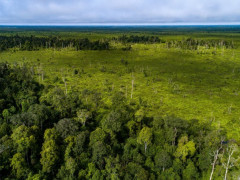The Story of Peat on Meranti
By Almo PradanaUnraveling the Chaos of Peatlands in Jambi
In the last two decades, peatlands in a number of areas in Jambi have slowly been converted to oil palm plantations and large-scale industrial forest plantations. Drainage and fires have accelerated the loss of peat ecosystems.
Indonesian Forum for the Environment (Walhi) Jambi data reveals that approximately 70 percent of the 751,000 hectares of peatland in the East Tanjung Jabung, West Tanjung Jabung, and Muaro Jambi Districts have been drained and cleared for oil palm and industrial forest plantation (HTI) permits.
Ironically, the government gave approval for the Indonesia Oil Palm Plantation Fund Management Agency (BPDPKS) to replant oil palm in deep peat areas that should be restored. Replanting oil palm in Mekar Jaya Village, Sungai Gelam Sub-District, Muaro Jambi District will only exacerbate the damage to the peat ecosystem.
Peat that is continuously drained is very vulnerable to fires. For example, the 2015 land fires have been the worst in Jambi after the 1997/1998 fires. As a result, Jambi experienced a pollution crisis and severe damage to the peat ecosystem.
The 2016 World Bank report states that the forest and land fires in 2015 were one of the largest fires in Indonesia after the 1997/1998 fires, which resulted in global losses of up to Rp 221 trillion or equivalent to USD 16.1 billion. BNPB also noted that half a million people were hospitalized and dozens died.
Data from the Jambi Provincial Forestry Agency revealed that 80% of the 900,000 hectares of peatland area in Jambi was damaged by the fires in 2015. This was worsened by the reoccurring fires in the following year. In fact, the burnt area in 2019 increased significantly from the previous three years.
The Peatland Restoration Agency has set a target to restore 200,772 hectares of peatland consisting of 46,415 hectares in protected areas, 25,885 hectares in unlicensed cultivation areas, and 128,472 hectares in licensed cultivation areas.
Unfortunately, the peat restoration efforts in Jambi have not gone smoothly. The Jambi Peat Community Network (JMGJ) found that the construction of canal blocks did not meet the standards and was even damaged. The borehole wells that were built also did not function properly.
The investigation carried out by Walhi Jambi and JMGJ found that 8 oil palm plantation companies were proven to have failed to restore and prevent forest and land fires. There were no canal blockings, monitoring towers, as well as inadequate infrastructure and firefighting teams. Ironically, 7 of these companies are included in the restoration indicative map.
KKI Warsi's records also indicate poor peat protection in the companies’ concession areas. This is proven by the fact that more than 20 company concession areas experienced reoccurring fires in 2015 and 2019.
Flora and fauna
Hundreds of thousands of flora and fauna are threatened in line with the increasing pressure and threats to peatlands in Jambi. For years, peatlands have supported thousands of flora and fauna with their nutritional needs. Forests on peatlands also serve as a habitat for vulnerable species and near-threatened species, such as the Sumatran tiger.
The peat swamps in Jambi are also very rich in freshwater fish. Swiss researcher, Maurice Kottelat, found that the world's smallest fish Peadocypris progenetica mainly found around peat swamps and rivers in Kumpeh Ilir, Muaro Jambi District. This fish only has a length of 7.9 mm (female) and 9.8 mm (male).
However, disasters occur almost every year. Many species were evicted from their habitats and even killed due to forest and land fires. When the Berbak Sembilang National Park forest in the East Tanjung Jabung area caught fire in 2019, Sumatran tigers were found in densely populated settlements. These tigers most likely came out to save themselves as their habitat was burning.
This is certainly very concerning for protected species, such as the Sumatran tiger. In addition to triggering conflict with humans, the Sumatran tiger will also be hunted. Current estimations show that only approximately 400 Sumatran tigers are living in the wild.
Disaster-prone
Forest loss and peat swamp damage are not only a serious threat to the king of the forest but may also trigger disasters.
When forest cover decreases and peatlands have been damaged, Jambi becomes prone to disasters, not only to forest and land fires but also to floods. In fact, the floods in Jambi occur in line with the peatland and forest cover loss. KKI Warsi noted that the forest cover area in Jambi was less than 900,000 hectares in 2020. Many forests have been converted into plantations, HTI, and mining areas.
The Omnibus Law made things worse. The government seems to give a red carpet to entrepreneurs to extract resources without considering the environmental impacts.
This universal law seems to facilitate the destruction of forests. The minimum requirement of 30% of forest area, especially in watersheds or islands, has now been removed. Companies are no longer directly responsible for fires that occur in their concession areas.
The Omnibus Law also robs indigenous people of its local wisdom. Fears of new issues also arise. In the case of forest and land fires, smallholders are prone to be criminalized because they are considered to have caused the fires due to the merun culture. At the end of the day, food issues will also occur because smallholders are unable to cultivate the land. The government does not seem to be aware that community involvement is the key to successful peatland management.
The threat of forest and land fires has occurred again this year. The Meteorology, Climatology, and Geophysical Agency (BMKG) in Jambi gave a warning that this year's drought is expected to be drier than before.
In 2020, the Regional Disaster Management Agency (BPBD) of Jambi Province has mapped at least 258 villages on the list of land and forest fire-prone areas. More than 100 villages are located in peat areas in West Tanjung Jabung, East Tanjung Jabung and Muaro Jambi Districts. In general, these villages are located around the concession areas of oil palm plantation companies.
The challenge of halting recurring fires is becoming more challenging. Although the Jambi Provincial Government has set a forest fire alert status from March 15 to 31 October 2021 as a measure to anticipate and control forest and land fires, it is more important to understand the causes of fires. Not only due to intentional burning but because damaged peatlands are very prone to fires. Restoration needs to be carried out as soon as possible to prevent recurring fires in Jambi.
*This opinion was shared by the Director of the Jambi Green Association and the Coordinator of Simpul Jaringan Pantau Gambut Jambi
** THIS ARTICLE WAS PREVIOUSLY PUBLISHED IN AKSESJAMBI, JAMBI-INDEPENDENT, JAMBERITA, SWARANESIA, JAMBIONE, AND PATRIOTIK ON 30 APRIL 2021




